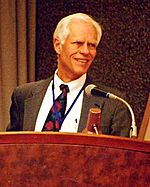William M. Hartmann facts for kids
Quick facts for kids
William M. Hartmann
|
|
|---|---|

William M. Hartmann
|
|
| Born | July 28, 1939 (age 86) |
| Alma mater | Iowa State University University of Oxford |
| Scientific career | |
| Fields | Psychoacoustics, Condensed matter physics |
| Institutions | Michigan State University University of Oxford |
| Doctoral advisor | Roger Elliott |
William M. Hartmann, born on July 28, 1939, is a famous scientist. He is a physicist, a psychoacoustician (someone who studies how we hear sound), and an author. He also used to be the president of the Acoustical Society of America.
He is known for his work on how we hear different musical notes (pitch), how our two ears work together (binaural hearing), and how we figure out where sounds come from (sound localization). With his team, he found new ways our ears hear pitch. These discoveries include the binaural edge pitch and the pitch shifts of mistuned harmonics. His book, Signals, Sound and Sensation, is used in many classes about how we hear. He is currently a physics professor at Michigan State University.
Contents
Early Life and Education
William M. Hartmann was born in Elgin, Illinois, USA. This was on July 28, 1939. He studied electrical engineering and physics. He went to Iowa State University in Ames, Iowa. He earned his first degree there in 1961.
He then received a special scholarship called a Rhodes Scholarship. This allowed him to study theoretical physics. He went to Oxford University in England. His teacher there was Sir Roger Elliott. Dr. Hartmann earned his Ph.D. in 1965. After that, he did more research at Argonne National Laboratory. This was from 1965 to 1968.
Career at Michigan State University
In 1968, Dr. Hartmann joined the Physics Department at Michigan State University. He is still a professor there today. At first, he studied how atoms vibrate in crystals. He was the first to show how to include certain details about defects in crystals. Later, he studied how electrons and vibrations interact in metals. He made the first calculation of how much heat is needed to melt metals.
In 1974, he started teaching a class about the physics of music. This made him very interested in how humans hear. In 1976, he changed his focus to psychoacoustics. He has been working in this field ever since. He also teaches in the Psychology Department at Michigan State University.
Research on How We Hear
Dr. Hartmann's research in psychoacoustics looks at several things. He studies how we hear musical notes (pitch perception). He also researches how we detect sounds and changes in sounds. Another big part of his work is how we locate where sounds come from.
His pitch research focuses on small effects in the ear. These effects likely start in the outer parts of our hearing system. His work on sound localization looks at how room echoes can confuse us. He also studies the ways listeners deal with these echoes.
Books and Awards
Dr. Hartmann has written an important textbook. It is called Signals, Sound, and Sensation. This book was published in 1997. He also helped edit the Springer Handbook of Acoustics in 2007. He has written over 75 articles for science journals.
He also has a patent for a special way to record sound. This method makes recordings sound very realistic. It helps you hear where sounds are coming from in the recording. The New York Times even wrote an article about it in 1999.
In 2001, Dr. Hartmann received a special award from Michigan State University. He also received the ASA Silver Medal from the Acoustical Society of America. Later, in 2017, he received the highest honor. This was the ASA Gold Medal. It was given to him for his work in hearing research and for helping the Acoustical Society.
Leadership in Science
Dr. Hartmann has been a fellow of the Acoustical Society of America since 1983. He led the committee for musical acoustics. He was also on the Society's main council. In 1996, he gave a special talk about pitch and the brain.
He served as vice president of the Society from 1998 to 1999. Then, he became president from 2001 to 2002. As president, he worked to connect the Society with other groups. He also helped the Society grow its presence around the world.

